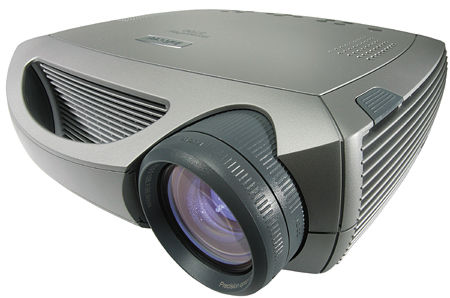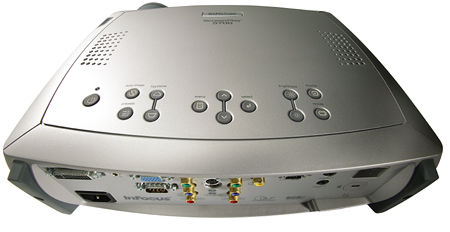InFocus ScreenPlay 5700 DLP Projector

Perhaps the new InFocus ScreenPlay 5700 projector will help tilt the scales of consumer interest more toward DLPs. Instead of just a flat TV, you can have a projector that delivers a far more cinematic experience. Now that's sexy.
Current Technology
The ScreenPlay 5700 is built around Texas Instruments' new Matterhorn DMD chip. With a native resolution of 1024x576 and a native 16:9 aspect ratio, the Matterhorn is well suited for dedicated home-theater applications (although it can't display HD sources in full resolution). Faroudja's DCDi chipset handles all the scaling, 3:2 pulldown recognition, video noise reduction, and deinterlacing.
The 5700's 5x-speed, 6-segment color wheel has been color-corrected so that, when coupled with the dual-power (220/250W) UHP lamp, the projector will produce a true 6500-kelvin color temperature. I've seen similar specifications before, but they were attached to DLP projectors with price tags in excess of $12,000. The 5700's street price is less than half that.
As you might expect from a projector designed specifically for home theater (as opposed to a repackaged business-presentation model), the ScreenPlay 5700 has no audio inputs or minuscule built-in speakers. Instead, it offers a myriad of video input options: two component, two S-video, one composite, one D5, one HD15, and one M1-DA.. The latter can accommodate a variety of formats (see "Specifications" sidebar), but not readily. In particular, this is the only input that can be used for a DVI source (the projector is also HDCP-compatible), but to do so you'll need an MD-1A to DVI-D adapter cable. InFocus can provide one, but it is not included with the projector (see sidebar, "Calibration & Comments").

All eight inputs are available via the remote's Source button, and you can program the remote's four dedicated source buttons to select the four sources you use most often. Two 12V triggers and a serial connector allow the 5700 to be integrated into even the most complex automated system.
Setting up the ScreenPlay 5700 won't cause any brain damage. InFocus makes a ceiling-mount kit (part SP-CEIL-005) as well as a false ceiling plate (part SP-LTMT-PLT) and an adjustable (26–47 inches) extension arm for the projector mount (part SP-LTMT-EXTP). Because the 5700 weighs less than 10 pounds, anything more substantial than duct tape and baling wire should affix it securely to the ceiling.
The projector does need to be laterally centered in relation to your screen, but its digital keystone control can compensate for some range of variation in height. Of course, the less keystone you use, the better off you'll be, but small amounts of correction in my setup exhibited none of the artifacts this feature can produce. Although the ScreenPlay 5700 lacks motorized focus or zoom, I doubt you'll miss them. Using the handy internal grid test pattern, you'll need to adjust focus and zoom only once; thereafter (barring earthquakes), the 5700 should remain set for life.
The lens has a different zoom range from other DLP projectors I've reviewed. It has a longer throw, which means it must be farther away from the screen than a standard-zoom lens to produce an image of the same size. The positive effects of this greater distance include lower levels of optical distortion and audible noise (the projector is farther away from the seating area). However, the longer throw will make it difficult to obtain as large an image in a small home theater. In my room, placed where I normally situate DLP projectors, the ScreenPlay 5700 could produce a picture only 61 inches wide, instead of a screen-filling 72 inches.
The menu system proved to be quite usable. Its hierarchical arrangement makes access to some of the more esoteric adjustments tedious, but the more common controls require only a few button pushes. The remote itself gets high points for ergonomic functionality. Besides its being backlit, common adjustments such as aspect ratio, contrast, source selection, brightness, and blanking (which gives you access to test patterns) have their own dedicated buttons. The combination of multiple infrared eyes on the projector and their wide angles of acceptance meant I never had to push a button more than once to achieve the desired effect, regardless of where I'd pointed the remote. For overall user interface, the ScreenPlay 5700 gets an A+.
Current Performance
Some reviewers find little, if anything, to criticize about the images from single-chip DLPs, but I'm among that small minority whose visual sensitivities are rubbed the wrong way by a fundamental shortcoming of the technology. Yes, I'm talking about the "rainbow effect." Even the ScreenPlay 5700, with its higher-speed color wheel, produced rainbows for me. While not as obnoxious or as obvious as those I saw from the Plus HE-3100, the cumulative effect of the ScreenPlay's rainbows made it difficult for me to spend more than an hour watching films without serious visual fatigue. After more than two hours, I often had a headache. Some people are far less sensitive to rainbows; I strongly recommend that anyone contemplating buying a DLP projector spend at least an hour watching to determine if it bothers them. They may or may not be a problem, depending on your sensitivities. [Dark scenes with bright highlights, such as lights on a dark street, frequently trigger rainbows for those susceptible to them. Include material such as this in your viewing tests. You'll rarely see rainbows on brightly lit material such as the animation favored by many dealers for video demonstrations].—TJN]
Black levels have always been another difficult performance area for DLP projectors. Because their light source—a bulb—is never fully off, their blackest black is not as black as what can be obtained from a CRT projector. But just because a DLP projector can't do absolute black doesn't mean it can't produce good shadow detail (although this is another traditional weakness of DLP technology, due mostly to a limited contrast ratio). The ScreenPlay 5700 did a fine job of retaining shadow information, even on such difficult material as The Lord of the Rings: The Two Towers (New Line Home Entertainment N6355), whose many nighttime battle scenes present an extreme challenge for any micropixel device.





























































